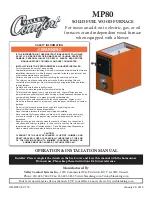
III.
HEAT EXCHANGER AND FLUE PIPE
Ordinarily, it is not necessary to clean heat exchanger or flue pipe
every year, but it is necessary to have your service technician
check unit before each heating season to determine whether
cleaning or replacement of parts is required.
If cleaning is necessary, the following steps should be performed:
1. Turn off all oil and electrical supplies upstream of furnace.
CAUTION:
If furnace has been in operation, some
surfaces may be hot. Allow time for unit to cool down.
2. Disconnect flue pipe.
3. Remove collar on flue connection.
4. Remove upper rear panel.
5. Remove flue collector box from secondary heat exchanger
tube flange. This exposes inside surfaces of secondary tubes
of heat exchanger.
6. Clean secondary tubes and flue pipe with a stiff brush and
vacuum cleaner.
7. If only secondary tubes need to be cleaned, no further
disassembly is required. Proceed to item 18 for reassembly.
If primary heat exchanger section is also to be cleaned
proceed to next item.
8. Disconnect limit control wires.
9. Disconnect oil line and remove oil burner from furnace.
10. Remove observation door.
11. Remove collar on observation tube.
12. Remove intermediate panel. Care must be taken not to bend
or damage limit control.
13. Loosen to hand tightness the 3 nuts labeled "A" in Fig. 4.
Remove screws labeled "B" in Fig. 4. Slide combustion
chamber forward out of heat exchanger. Be careful not to
bump combustion chamber as it becomes brittle after
having been fired.
14. Use a stiff brush and vacuum cleaner to clean inside of
primary drum.
CAUTION:
Never use incendiary type cleaners (smoke
sticks) for cleaning!
WARNING:
For all heat exchanger plates that have
been removed, the gaskets MUST be replaced. Failure to
replace gaskets could lead to heat exchanger leakage,
sooting, and a hazardous condition which could lead to
bodily harm.
15. Before reassembly, heat exchanger and combustion cham-
ber should be inspected to determine if replacement is
required. After cleaning, place combustion chamber back
into primary drum and secure with "B" screws. Use 35-45
lb-in. of torque. Ensure that cover plate gasket is in place
before tightening screws. Care must be taken not to damage
combustion chamber.
16. Tighten "A" nuts to 30 lb-in. of torque (firm, but not overly
tight).
17. Replace intermediate panel, observation tube collar, obser-
vation door, limit wiring, and oil burner.
18. Replace collector box on secondary tube flange, ensuring
proper placement of gasket. Tighten screws to 35-45 lb-in.
of torque.
19. Replace upper rear panel and flue collar.
20. Reconnect flue pipe and oil line(s) if removed.
21. Readjust burner for proper operation. Check limit operation
as outlined in Limit Control Check section.
IV.
BLOWER OILING AND REMOVAL
Periodic oiling of blower motor may be necessary. Check for
instructions on inside of blower access panel.
If it is ever necessary to remove blower from furnace, refer to Fig.
5 and perform the following:
1. Turn off all electrical power to furnace.
2. Remove louvered door and blower door.
3. Remove blower retaining screw (on blower partition panel
near corner where intermediate panel and blower partition
meet).
4. Remove cover from control box and disconnect thermostat
and power wires from board.
5. Remove 3 screws holding control box to blower partition.
6. Slide blower on rails toward front of unit until motor wire
connections at terminal block on motor can easily be
reached and disconnected.
7. Disconnect motor wires at terminal block on motor and then
disconnect 2 red wires connected to auxiliary limit control
mounted on opposite side of blower.
8. Swing control box out of way of blower and remove blower
from unit.
→
Fig. 4—Removing Combustion Chamber
A96398
A
B
Fig. 5—Removing Blower
A95486
REMOVE 3 SCREWS
TO REMOVE
JUNCTION BOX
BLOWER
RETAINER
SCREW
—9—
→
→
→
→
→
→


































